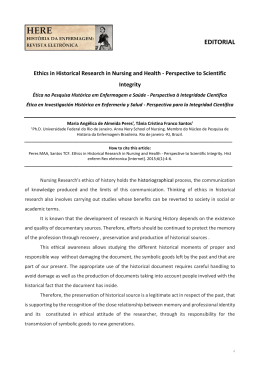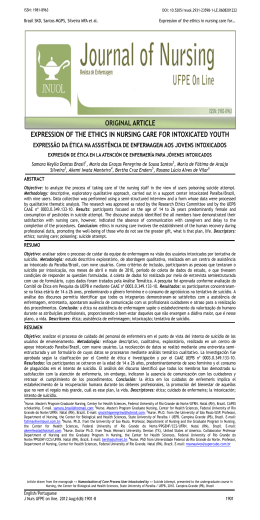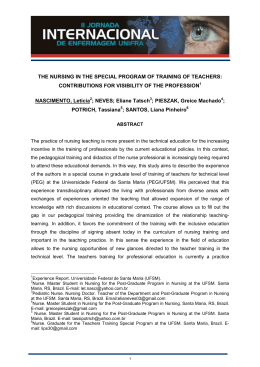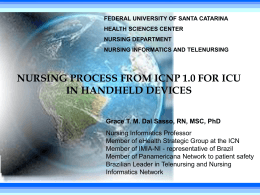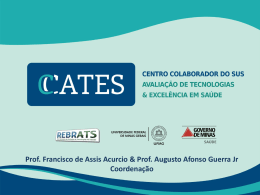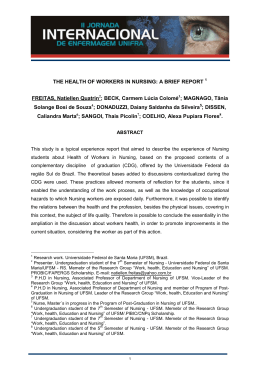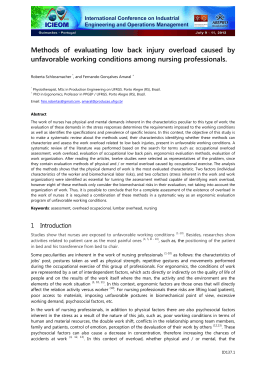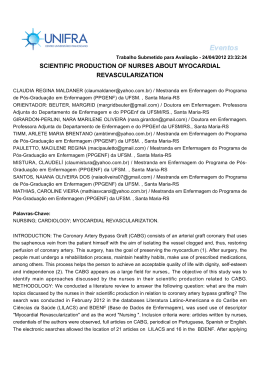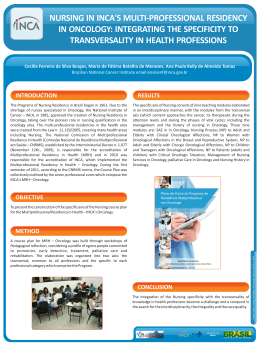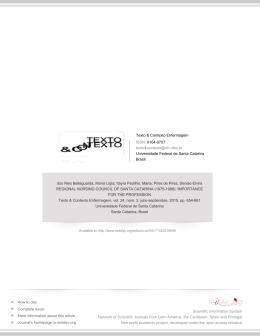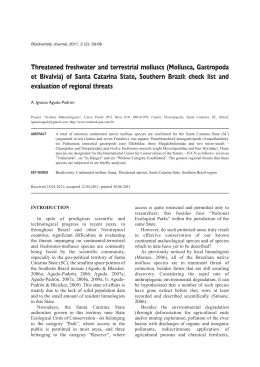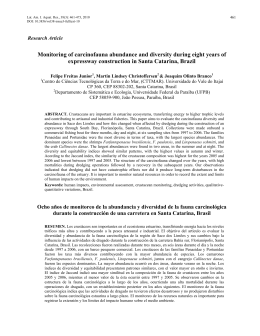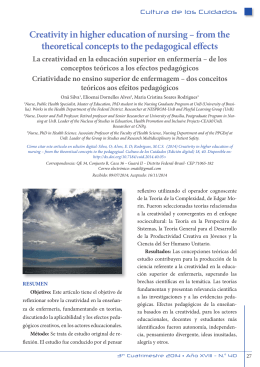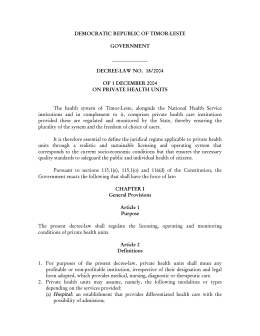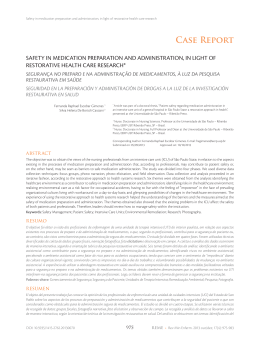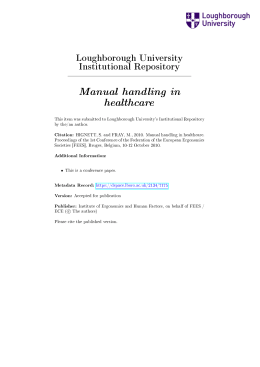ATINER CONFERENCE PAPER SERIES No: LNG2014-1176 Athens Institute for Education and Research ATINER ATINER's Conference Paper Series NUR2015-1461 Nursing Education Focused on Healthcare Workers Leticia De Lima Trindade Researcher and Professor Santa Catarina State University & University of Community Region Chapeco Brazil Vanderleia Muller Nurse University of Community Region Chapeco Brazil Lucimare Ferraz Teacher Santa Catarina State University & University of Community Region Chapeco Brazil 1 ATINER CONFERENCE PAPER SERIES No: NUR2015-1461 An Introduction to ATINER's Conference Paper Series ATINER started to publish this conference papers series in 2012. It includes only the papers submitted for publication after they were presented at one of the conferences organized by our Institute every year. The papers published in the series have not been refereed and are published as they were submitted by the author. The series serves two purposes. First, we want to disseminate the information as fast as possible. Second, by doing so, the authors can receive comments useful to revise their papers before they are considered for publication in one of ATINER's books, following our standard procedures of a blind review. Dr. Gregory T. Papanikos President Athens Institute for Education and Research This paper should be cited as follows: De Lima Trindade, L., Muller V., Ferraz, L. (2015). "Nursing Education Focused on Healthcare Workers", Athens: ATINER'S Conference Paper Series, No: NUR2015-1461. Athens Institute for Education and Research 8 Valaoritou Street, Kolonaki, 10671 Athens, Greece Tel: + 30 210 3634210 Fax: + 30 210 3634209 Email: [email protected] URL: www.atiner.gr URL Conference Papers Series: www.atiner.gr/papers.htm Printed in Athens, Greece by the Athens Institute for Education and Research. All rights reserved. Reproduction is allowed for non-commercial purposes if the source is fully acknowledged. ISSN: 2241-2891 13/06/2015 ATINER CONFERENCE PAPER SERIES No: NUR2015-1461 Nursing Education Focused on Healthcare Workers Leticia De Lima Trindade Researcher and Professor Santa Catarina State University & University of Community Region Chapeco Brazil Vanderleia Muller Nurse University of Community Region Chapeco Brazil Lucimare Ferraz Teacher Santa Catarina State University & University of Community Region Chapeco Brazil Abstract The study aims to analyse the potential of inserting occupational health related tasks and training options in the context of the pedagogical projects of undergraduate nursing in Southern Brazil. A qualitative, descriptive approach is adopted, in which a case study is conducted. The sample consists of 62 students and six faculty members from three nursing study programmes in the West of Santa Catarina. Data were collected in the period between August 2013 and February 2014, through focus groups interviews. Documental analysis was conducted using the Content Analysis method. Results pointed out the absence of specific curriculum components and the existence of influences from the Collective Health and Occupational Health. Theoretical and practical activities, internships, research and extension have been only offered in a restricted and discontinuous way. The present study highlights the urgency for policy expansion and intervention in the field of the educational services provided in nursing schools, focused at specific groups of workers. 3 ATINER CONFERENCE PAPER SERIES No: NUR2015-1461 Introduction In Brazil, the elements of nurse education are defined in the context of the National Curricular Guidelines (NCG). Namely, nursing training aspires to provide future nurses with professional knowledge and assist them in acquiring competences and skills in the fields of health care, decision-making, communication, leadership, administration, management and lifelong learning (Ito et al. 2006, Brasil 2001, Silva et al. 2011). The structure of the nursing undergraduate programs in Brazil has been greatly influenced by the evolution of the national and international, political, economic, social and health framework, being a significant determinant of nursing education. The interactions between the labor market needs in nurses and the relevant implemented policies determine the provision of nursing training and its guidelines in Brazil. The great influence of the Unified Health System (UHS), introduced in the aftermath of the Sanitary Reform Movement in the 1990s, should also be taken under consideration (Brasil 1990). UHS’ basic principles are the universality, equity and comprehensiveness of the health care provision, at all levels of complexity, from primary care to hospital assistance (Ceccim and Feuerwerker 2004). In this context, NCG had to be transformed to conform to the basic guidelines of the Unified Health System (UHS), being based on a wide network of primary care facilities, filtering patients’ inquires for all the types of health care. NCG for nursing courses were defined in 2001, stating the fundamental principles for the preparation of critical and reflective health care professionals guided by the ethical principles prevailing in the contemporary historical and social context, and capable of providing effective solutions to patients’ problems (Ceccim and Feuerwerker 2004). According to UHS’ baseline principles, health professionals, being responsible to care for public health in a universal level, should be able to provide care to all individuals in all sorts of health situations, stages of the life cycle and life and work scenarios. Working can be considered as one of the main, everyday activities, often resulting in various health problems. Undoubtedly, labor, greatly contributes to human and societal development technological advances and the establishment of significant interactions between social groups. However, labor may cause several changes in WH, determining the health-disease process for all individuals engaging in such activities (Oddone 1986). In Brazil, all men and women who engage in activities to financially support themselves and/or their dependents, are defined as workers, independently of the level of their labour market integration and of the sector in which they are employed (formal or informal). Wage earners, domestic workers, detached, rural, autonomous or temporary workers, civil servants, members of cooperatives and employers, particularly owners of microproduction units and services, are all categorized as “workers”(Brasil 2006). For the development and implementation of an efficient public policy mixture for the protection of workers' health, professionals offering their 4 ATINER CONFERENCE PAPER SERIES No: NUR2015-1461 services by the principles of UHS are required. The relevant UHS guidelines are centered on the prevention of occupational diseases, treatment and rehabilitation as well as promotion of workers’ good health. In this context, WH should be considered a social practice with its implementation in the area of public health being an issue of critical importance, as it would most certainly contribute to the improvement of public health (Brasil 2004). However, reviewing the existing literature shows that there is a lack of investment in the training of professionals, being co-responsible for Brazilian workers’ health (Silva et al. 2010). Thus, the conceptualization of workers’ health needs to be redefined in a broader manner, in order to raise awareness for its protection not as a mere production factor but also as an autonomous concept. In addition, expanding the public knowledge regarding the influence of working conditions on health, will contribute in the prevention of typical workplace accidents and occupational diseases and in the advancement of the public discourse about the health problems related to work. Workers’ knowledge and control over their working conditions are key prerequisites for effective health protection (Lacaz 2010). Within the scope of these general notions, the National Workers’ Policy Health to Men and Women was introduced in 2012. This policy mixture aims to define the principles, guidelines and strategies for the comprehensive provision of health care to workers, being under the control of the three spheres of UHS management. This set of principles, guidelines and strategies puts the emphasis on the protection of workers against the risks of morbidity and even mortality related to working conditions (Brasil 2012). It is up to health care professionals to assist workers by understanding the potential causal relation between their workplace conditions and their healthdisease and treating them as singular subjects with special needs. They are also responsible for being aware of the evolution of the production process, the adoption of new technologies. It is required that they are capable of exercising their right as well as protecting the workers’ right to information access and take on protective, preventive and recovery measures for the improvement workers’ health, aiming at work conditions humanization (Ito et al. 2006). On this ground, the study aims to understand the integration prospects and perspectives of inserting of occupational health related tasks and training options in the context of the pedagogical projects of undergraduate nursing in Southern Brazil. Methodology Descriptive, qualitative research is conducted, based on a case study (Yin 2010). Such a design was chosen in order to investigate the subject in depth and in its real life context (Yin 2010), especially taking under consideration the 5 ATINER CONFERENCE PAPER SERIES No: NUR2015-1461 boundaries between the actual phenomenon and the specific context selected in the investigation. Data were drawn from a Nursing undergraduate course in a federal university (FC), a state course (SC) and a community one (CC), all being taught in the western region of Santa Catarina. According to the Brazilian Institute of Geography and Statistics (Instituto Brasileiro 2010), the West region's population appeared to be around 1,200,230 inhabitants in the 2010 census. Data collection involved document analysis of the courses’ pedagogical projects (CPP), as manifested in their structure, objectives, references and contents described in the syllabus as well as in their extracurricular activities focusing on worker health. For purposes of reliability, a guidance protocol for the completion of data collection was created, including an overview of the study, field procedures, survey questions and some suggestions for the development of the report (Yin 2010). Data are analysed on the basis of the Content Analysis method (Minayo 2010). At the structured pre-analysis stage, all communications obtained were thoroughly documented, then following the available material was carefully described and finally, key elements of the teaching-learning process were encoded. The study was approved by the Research Ethics Committee of Unochapecó, and followed the ethical guidelines recommended by Resolution 466/12 of the National Health Council (Conselho 2013) No. 115/13. Among other, the institutions surveyed were requested to sign the term sheet allowing formal access to the data. Results and Discussion According to the Ministry of Education (MEC), 24 registered higher education institutions with nursing undergraduate degree currently operate in Santa Catarina; five of them are located in the state's western region, 80% out of which in Chapecó, the present study’s field of research (Ministério da Educação 2014). It is observed that the region experiences significant expansion in the university departments, mainly those related to the health sector. The region’s economic activities are mainly based on the sectors of livestock, poultry and swine, concentrated in the Great West of Santa Catarina. In these sectors, 65,000 people are employed, accounting for a share of approximately 75% of Brazilian’s total exports in the business. Activities related to agribusiness, specially poultry and swine are also common in the region (Mattei and Lins 2010. According to the Basic Education Index, Santa Catarina has the highest score in the country.from the 1st to 5th year (public and private) in 2011 5.8 ranking second on the national scene; from the 6th to 9th year (public and 6 ATINER CONFERENCE PAPER SERIES No: NUR2015-1461 private) in 2011 4.9 taking the first place and in high school (public and private) in 2011 to 4.3, also first place (Instituto Nacional 2012). On the basis of content analysis method, among the surveyed courses, two of them were identified to offer general nursing training and the remaining one offers public health nursing education. The basic pillars of the public health nursing education are grounded in the principles and guidelines of UHS, engaged in promoting a new health care model. In the context of this model, the collective interest programs, health protection promotion strategies, protection, recovery and rehabilitation as well as guarantee of the rights of the citizens constitute priorities (Brasil 1990). The CC curriculum comprises 47 compulsory components organized in thematic groups, without specifying the electives linked specifically to the programme, the offer of WH and components that form within the HEI, also offered to other courses by the institution The SC comprises 51 compulsory curriculum components and nine electives, which vary each year, according to the course’s demands. The FC includes 47 required components and eight electives, categorized in three domains: common, related and specific. The current curriculum proposal in the three courses in data collection period is structured in phases, nine stages in the community course (CC) and the state course (SC). But the federal course (Fc) is constituted in ten stages. The CC began to operate in the period 1999/2000, so it counts approximately 14 years of operation while the SC started in 2004, counting about 10 years of activity. In 2010, the FC was introduced, not having completed its first class so far as it has been in operation for just the last four years. The implementation of the Minimum Curriculum template is required by the MEC as the LDB, which reorders higher education. Regarding nursing training programs, the document CNE / CES nº 33/2007, approved on February 1st, 2007, which sets the guidelines for minimum workload, duration and completion of undergraduate programs (Brasil 2007). The Minimum Curriculum suggests that the program should be completed in a five-year span, lasting 4.000h in day-time turn (Brasil 2007). Since evaluation on the basis of the Curriculum was only establish in 2007, the programs are still gradually adapting to its principles. Consequently, institutions operate with different matrices in progress. It is understood that the transition process to a common curriculum entails challenges regarding higher education in nursing thus, making the examination of such a process quite informative regarding the characteristics of the nursing programmes. The documentary analysis concluded that from CPP was sought to curricular matrices of the courses emphasized the following results. In the FC matrix, there were three courses on Occupational Health offered in the 1st, 2nd and 4th phases respectively. The relevant modules are centered on policies related to UHS and workplace surveillance. Still, the program has the optional subject turned into topic, not yet offered. In the current curriculum of the State program, there were nine courses on Occupational Health offered in the 1st, 2nd and 3rd, 4th, 5th, 6th and 7th phases respectively. The courses are mainly about biosafety, UHS principles 7 ATINER CONFERENCE PAPER SERIES No: NUR2015-1461 and guidelines, health promotion, popular education, health risks of the production process, social and labor relations, nursing as a social service, pesticide use, health surveillance, worker immunization, health care policies focused on workers, occupational health and prevention of work accidents. The state program also has a research group dedicated to the study of health in the workplace. In the current curriculum of the community college, being the only one having a thematic group structure, eight courses involving worker health issues were offered in 1st, 2nd, 3rd, 4th, 5th, 7th and 8th stages respectively. The modules are on sustainability, public policies, ergonomics, care-giving, health surveillance, bio-safety, UHS and its relation to occupational health. The results indicate that there exists a variety of modules on workers' health, included in the undergraduate nursing programmes, with the areas of surveillance and bio-safety being at the centre of attention. Modules regarding public policies and the health system have currently been introduced, yet still timidly. It was also observed that the disciplines’ objectives, arranged in lists, do not focus on student preparation to better assist workers and serve their needs in various workplace contexts. In this sense, flexibility in the provision of curriculum components, mainly the elective ones, is considered important, as it could fill the existing gaps. In addition, the expansion of spaces for debate on these issues, based on teachers’ availability and qualification, is considered critical. Among the elements considered essential for what was envisioned in Nursing Minimum Curriculum to be realised, the need to introduce an academic model emerges. Such a model should include the expansion of teaching scenarios for different levels of health services, education and community organizations, innovations on the thematic content in nursing curriculums as well as in teaching up to date methodologies, the pedagogical and didactic preparation of teachers, and the modification and implementation of new evaluation models of the teaching-learning process. All these constitute challenges in the process of adapting and qualifying the common curriculum. The programs are also characterised by shortage of practical spaces for a training focusing on the provision of assistance to workers as well as of related research and extension activities. However, one of the programs features an elective discipline on worker health, though not yet offered, and a research group dedicated to the study of the health work. Higher education expansion should also combine enhanced capacity to create actual mechanisms to academically qualify the system as a whole, as well as to address the need for an integrated plan, including initiatives for dealing with regional inequalities in higher education. New, high-quality knowledge is considered necessary for the realization of the above that, in its own turn, requires new professional profiles. In this context, the need for changes in the nature of the production process and the enhancement of workers educational foundation are implied. The emphasis is placed not only on technical-scientific knowledge, but also on the ethical, social, political and 8 ATINER CONFERENCE PAPER SERIES No: NUR2015-1461 cultural aspects of knowledge, as well as on the professional qualification requirements (Teixeira et al. 2006, Erdmann et al. 2011). The difficulties involved in the process of training health care providers following the perspective required by UHS is the subject of many studies. Training professionals to work in this health care model itself sets up a challenge. Taking under consideration the professionals’, patients’ and managers’ daily practice in the actual field, has proven crucial for the provision of solutions to the problems emerging in the health care area. Thus, improving the academic training of students and teachers of healthcare is also necessary (Batista and Gonçalves 2011). This trend is certainly reflected in the current approach adopted in the reform of higher education in health. The characteristics of educational institutions and the long distance they have to cover in order to conform to the principles and serve the needs of the public health system in Brazil pose various challenges to UHS in its attempt to organize the health care education (Araujo et al. 2007). Conclusions Undoubtedly, gaining deep understanding of the variety of theoretical and practical aspects related to workers health, which have been the in the center of the nursing undergraduate courses, enhances the skills and abilities of the health care professionals in relation to workplace related health. The teaching-learning process of the future nurses is found to be problematic in providing them with the qualifications necessary to provide health care services to workers. The curriculum and objective of the CPP nursing programs indicate the of the field concentrating the greatest deal of attention is biomedicine, with students primarily focusing on workplace accidents and the complexity, uniqueness and dynamics of the interactions between the worker and the workplace are ignored. Educational progress in the subject of worker health is considered to improve the performance of future professionals regarding the quality of care for workers in different production scenarios. Finally, nursing education has recently been in the center of the public discourse as a requirement for preparing qualified health care workers, reinforcing the magnitude of the influence of the Public Health principles in the training of these professionals. References Araújo D, Miranda MCG, Brasil SL (2007) Formação de profissionais de saúde na perspectiva da integralidade [Health professionals’s formation in the integrality perspective]. Revista Baiana Saúde Pública 31(1): 20-31. Batista KBC, Gonçalves OSJ (2011) Formação dos Profissionais de Saúde para o SUS: significado e cuidado [Health professionals’ formation for SUS]. Saúde Sociedade 20(4): 884-899. 9 ATINER CONFERENCE PAPER SERIES No: NUR2015-1461 Brasil - Ministério da Saúde (2012) Portaria n. 1.823, de 23 de agosto de 2012. Institui a Política Nacional de Saúde do Trabalhador e da Trabalhadora [Ordinance no. 1.823, August 23rd 2012. Establishing the Workers’ Health National Policy]. Official Journal of Brazil’s Federative Republic Section I: 46-51. Brasil - Ministério da Educação (2007) Curso de enfermagem o parecer CNE/CES no. 33/2007 [Nursing Course appear CNE/CES no. 33/2007]. Brazil: Education Ministry. Brasil - Ministério da Saúde (2006) Relatório Final/Anais da 3ª Conferência Nacional de Gestão do Trabalho e Educação na Saúde [Final Report/3rd Annals from the National Conference in Work Management and Health Education]. Maria Natividade Gomes da Silva Teixeira Santana, referendary. Brazil: Mimeo. Brasil - Ministério da Saúde (2004) Saúde no Brasil – Contribuições para a Agenda de Prioridades de Pesquisa/Ministério da Saúde [Health in Brasil – Contributions for the Research’s Priority Agenda/Health Ministry]. Brazil: Ministério da Saúde. Brasil - Conselho Nacional de Educação - Câmara de Educação Superior (2001) Resolução CNE/CES N. 3, de 07 de novembro de 2001. Institui as Diretrizes Curriculares Nacionais do curso de graduação em enfermagem. Diário Oficial da República Federativa da União [Resolution CNE/CES N.3, from November 7th 2001. Establishing the National Curriculum Guidelines from the nurse graduation courses. Oficial Journal from the Union’s Federative Republic]. 1:37. Brasil (1990) Lei 8080 de 19/09/1990 [Law no. 8080 from September 9th 1990]. Retrived from: http://conselho.saude.gov.br/legislacao/lei8080_190990.htm. [Accessed: 2 April 2013] Ceccim RB, Feuerwerker LCM (2004) Mudança na graduação das profissões de saúde sob o eixo da integralidade [Changes on health professions’ graduation under the integrality center line]. Public Health Guide 20(5): 1400-10. Conselho Nacional de Saúde (2013) Resolução Nº 466, de 12 de Dezembro de 2012, institui as diretrizes e normas regulamentadoras de pesquisas envolvendo seres humanos [Resolution n. 466, December 12th 2012, establishing the guidelines and standards regulating researches involving human beings]. Section 1: 59. Erdmann AL, Fernandes JD, Teixeira GA (2011) Panorama da educação em enfermagem no Brasil: graduação e pós-graduação [Nursing education’s prospect in Brazil: graduation and post graduations]. Enfermagem em Foco 2(Supl.): 8993. Instituto Brasileiro de Geografia e Estatística. Censo 2010. Dados: Santa Catarina [2010 Census. Data: Santa Catarina] (2010). Retrived from: http://www.censo 2010.ibge.gov.br. [Accessed: 10 March 2014] Instituto Nacional de Estudos e Pesquisas Educacionais Anísio Teixeira (2012) Índice de Educação Básica (IDEB) [Basic Education Index]. Santa Catarina. Rretrived from: http://www.inep.gov.br/. [Accessed: 10 March 2014] Ito EE, Peres AM, Takahashi RT, Leite MMJ (2006) O ensino de enfermagem e as diretrizes curriculares nacionais: utopia x realidade [The nursing teaching and the national curriculum guidelines: uthopia x reality]. Revista Escola Enfermagem USP 40(4): 570-5. Retrieved from: www.ee.usp.br/reeusp. [Accessed: 16 May 2014] Lacaz FAC (2010) Avesso do trabalho II: Trabalho, precarização e saúde do trabalhador [Work’s reverse II: Labour, precariousness and the worker’s health]. (1st edn.). Sao Paulo: Expressão Popular, Ch. 9: 199-230. 10 ATINER CONFERENCE PAPER SERIES No: NUR2015-1461 Minayo MCS (2010) O desafio do conhecimento: pesquisa qualitativa em saúde [The knowledge challenge: qualitative research in health]. (13th edn.). Sao Paulo: Hucitec. Ministério da Educação (2014) Instituições de Educação Superior e Cursos Cadastrados [Institutions of Higher Education and Registered Courses]. Retrived from: http://emec.mec.gov.br. [Accessed: 4 August 2014] Mattei L, Lins HN (2010) A socioeconomia catarinense cenários e perspectivas no início do século XXI [Scenarios and perspectives from catarinense’s social economy at the beginning of the 21st century]. Chapecó, SC: Argos. Oddone I (1986) Ambiente de trabalho: a luta dos trabalhadores pela saúde [Work environment: the worker’s fight for health]. Sao Paulo: Hucitec. Silva MJ, Sousa EM, Freitas CL (2011) Formação em enfermagem: interface entre as diretrizes curriculares e os conteúdos de atenção básica [Nursing formation: interface between the curriculum guidelines and the basic care subjects]. Revista Brasileira de Enfermagem 64(Supl. 2): 315-321. Silva MG, Fernandes JD, Teixeira GAS, Silva RMO (2010) Processo de Formação da (o) enfermeira (o) na contemporaneidade: Desafios e Perspectivas. [Nurse’s Formation Process in the contemporaneity: Challenges and Perspectives] Texto e Contexto Enfermagem, Florianópolis 19(1): 176-84. Teixeira E, Vale EG, Fernandes JD, Sordi MRL (2006) Trajetória e tendências dos cursos de enfermagem no Brasil [Paths and tendencies of nursing courses in Brasil]. Revista Brasileira de Enfermagem 59(4): 479-87. Yin RK (2010) Estudo de caso: planejamento e métodos [Study case: planning and methods]. (4th edn.). Porto Alegre: Bookman. 11
Download


